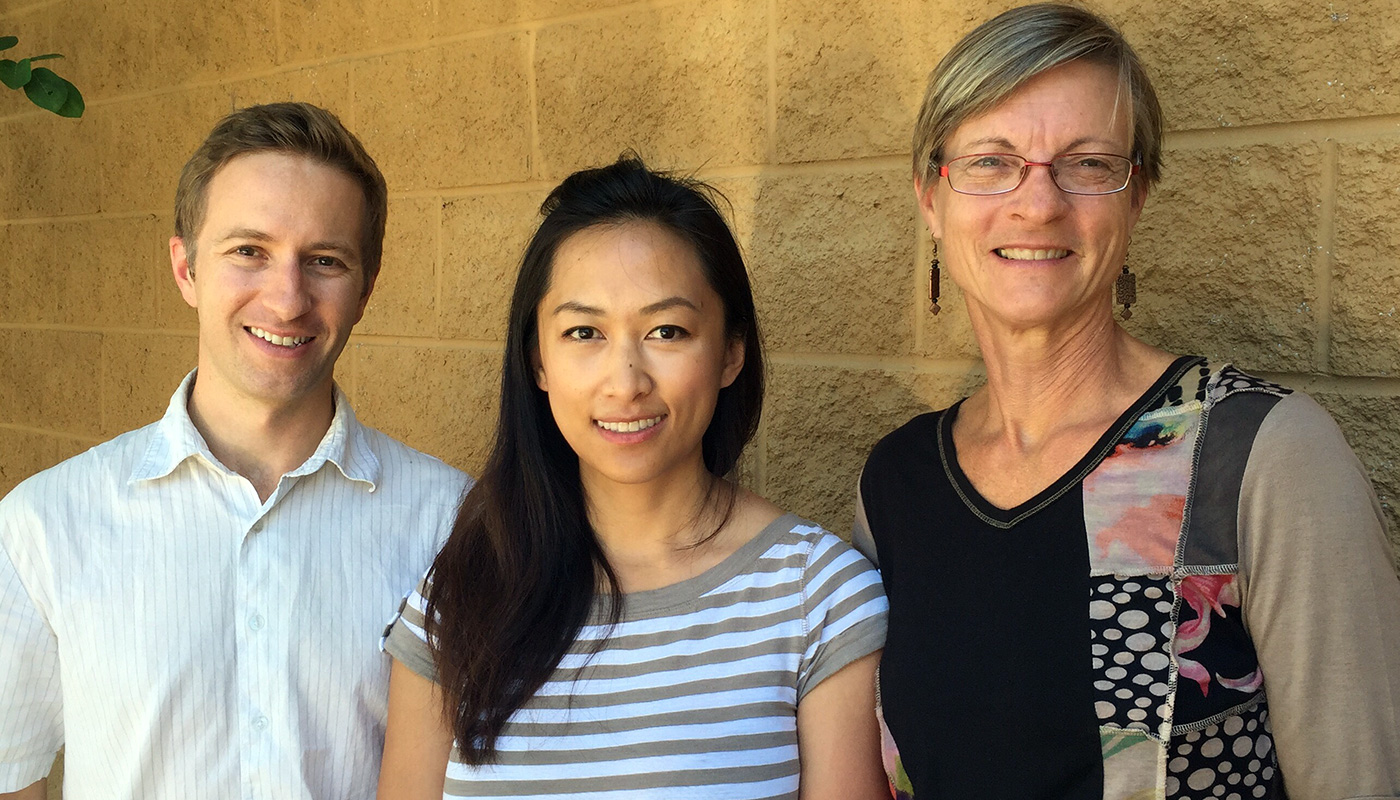
Left to right: Dan Knights, Pajau Vangay and Kathleen Culhane-Pera in front of West Side Community Health Services.
Immigrants make up a significant portion of Kathleen Culhane-Pera’s patient roster. As associate medical director of West Side Community Health Services, she regularly hears community concerns about chronic diseases such as obesity, diabetes and gout. “People say ‘we thought we were coming to the United States to be healthier and instead we are sicker.’”
Many immigrants face the paradox of leaving behind food insecurity and other threats only to confront new dangers to their health. While changes to diet may contribute to the increased risk for disease, the underlying mechanisms driving big bumps in chronic disease remain unclear. That’s where the Immigrant Microbiome Project comes in.
Led by Dan Knights, a computational biologist with joint appointments in the the College of Biological Sciences and the College of Science and Engineering, the project looks at the possibility that changes in the composition of the gut microbiome go hand in hand with a new location and lifestyle. The project builds on evidence in non-human primates suggesting just that.
A perfect “petri dish”
Minnesota is home to several large immigrant communities, making it an ideal location for a long-term look at the evolution of the gut microbiomes in those populations. The idea to focus on the microbiomes of various immigrant communities derived from a mix of easy access, personal interest and scientific expertise.
Pajau Vangay, a Ph.D. student in Knights’ lab with a background in computer science and food microbiology, came up with the idea. “I’m actually Hmong myself,” says Vangay. “And I have always wanted to work with the Hmong community.” When she arrived in the Twin Cities, Vangay reached out to community leaders and connected with Culhane-Pera. A collaboration was born. Since then, the researchers broadened the project’s scope to include another immigrant community, the Karen from Burma. Future projects could occur with other immigrant groups such as Somali, Nepali, Oromo, or Latino.
The investigators will conduct a pilot study that compares the microbiome of people who have been here for varying lengths of time and varying body sizes, as well as evaluates whether a fiber supplement supports growth of native bacteria. Ultimately, they hope to follow a cohort of newly arrived immigrants over time to understand how the microbiome changes the longer someone lives in the United States.
“We haven’t really seen anything like this in the literature,” says Vangay. “Existing studies tend to look at indigenous populations along the rural to urban gradient, but no one has looked at people who have moved here and are changing over time as far as we know.”
A gut microbe mystery
“Each population has a fingerprint,” says Knights, who notes that “microbial communities are very complex” and our understanding of the relationship between the mix of microbes in a particular population and disease risk is murky at best. “We know higher diversity is usually associated with a healthier state as would be true of a macro-ecosystem, but we really don’t know which features of a Western microbiome are problematic and which are benign.”
His hypothesis: when people move to this country, they lose their native microbiome and acquire an “American” microbiome characterized by lower diversity and higher levels of Bacteroides, associated with the consumption of protein and animal fat. One of the questions the researchers hope to answer is whether consuming high-fiber diets, as occurs in many people’s pre-migration diets, would lower disease risk.
Connecting with the community
The study is just getting off the ground, but Knights, Vangay and Culhane-Pera are taking a highly collaborative, community-driven approach. They are in the process of identifying community researchers—people from the populations being studied—to be partners, recruit participants, make decisions about the tools to use, collect data and work with the communities to decide how to best disseminate the results.
“The community is absolutely involved in everything except the lab investigation,” says Culhane-Pera. “Having this really unique cutting-edge view of chronic disease, it’s intriguing and exciting to think we could advance research and gain new knowledge while helping the community in a tangible way.” — Stephanie Xenos / August 2015
“We know higher diversity is usually associated with a healthier state as would be true of a macro-ecosystem, but we really don’t know which features of a Western microbiome are problematic and which are benign.”
The Immigrant Microbiome Project has received funding from Clinical Translational Science Institute, the Healthy Foods, Healthy Lives Institute, as well as a Multicultural Research Award from the University of Minnesota’s Office of Equity and Diversity.